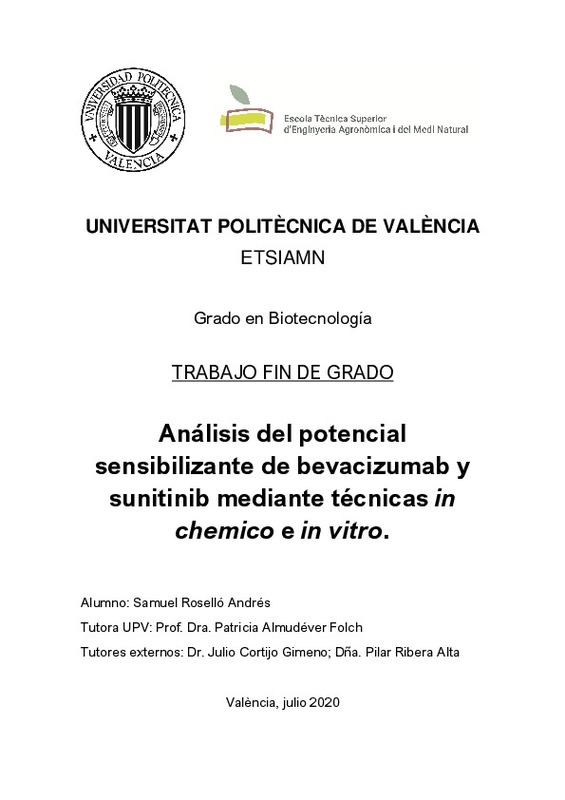|
Resumen:
|
[ES] La dermatitis de contacto alérgica (DCA) es la manifestación clínica ante la exposición a un agente sensibilizante. Este proceso de sensibilización cutánea comprende una serie de eventos clave que se conocen bien y ...[+]
[ES] La dermatitis de contacto alérgica (DCA) es la manifestación clínica ante la exposición a un agente sensibilizante. Este proceso de sensibilización cutánea comprende una serie de eventos clave que se conocen bien y que están recogidos en un Adverse Outcome Pathway (AOP) por parte de la OECD. Tradicionalmente, el estudio de sensibilización cutánea se llevaba a cabo en animales. Como resultado de la prohibición del uso de animales en experimentación para cosméticos, se desarrollaron una serie de técnicas in chemico e in vitro que permiten valorar tres de los cuatro eventos claves. Estas son: Direct Peptide Reactivity Assay (DPRA), una técnica in chemico que se enfoca en el primero de los eventos, es decir, la interacción covalente del hapteno con proteínas de la piel; KeratinoSens™, un ensayo in vitro dirigido al segundo evento, la activación de los queratinocitos de la piel, y, por último, el ensayo Human Cell Line Activation test (h-CLAT) que apunta al tercer evento clave, la activación de las células dendríticas y su expresión de marcadores de superficie específicos. Se ha demostrado que sunitinib y bevacizumab, dos antineoplásicos de amplio uso en terapias antiangiogénicas contra el cáncer, provocan reacciones de hipersensibilidad en los pacientes. Sunitinib es un inhibidor de múltiples receptores quinasa, entre los que se encuentran los receptores del factor de crecimiento endotelial vascular 1, 2 y 3 (VEGFR 1, 2, 3), implicados en la neoangiogénesis y la supervivencia tumoral. Bevacizumab es un anticuerpo monoclonal humanizado anti-VEGF, uniéndose de forma selectiva a todas las isoformas de VEGF y bloqueando su función. Así pues, este trabajo trata de estudiar mediante dichas técnicas el efecto sensibilizante de sunitinib y bevacizumab, y evaluar la incorporación de estas técnicas, como alternativa a los animales, en la fase preclínica de los candidatos a fármacos.
[-]
[EN] Allergic contact dermatitis is the clinical manifestation of exposure to a sensitizing agent. This skin sensitization process includes four key events that are well-known and collected in an Adverse Outcome Pathway ...[+]
[EN] Allergic contact dermatitis is the clinical manifestation of exposure to a sensitizing agent. This skin sensitization process includes four key events that are well-known and collected in an Adverse Outcome Pathway (AOP) by the OECD. Traditionally, the skin sensitization study was carried out in animals. As a result of the prohibition of the use of animals in cosmetic experimentation, a series of techniques were developed in chemico and in vitro to evaluate three of the four key events. These are: Direct peptide reactivity assay (DPRA), an in chemico technique that focuses on the first of events, i.e. the covalent interaction of the haptene with skin proteins; KeratinoSens™, an in vitro assay targeting the second event, the activation of skin keratinocytes, and finally the human cell line activation test (h-CLAT) that points to the third key event, the activation of dendritic cells and their expression of specific cell surface markers. It has been proved that sunitinib and bevacizumab, two antineoplastics widely used in antiangiogenic therapies against cancer, produce hypersensitivity reactions in patients. Sunitinib is a multi-receiver kinase inhibitor, including vascular endothelial growth factor receptors 1, 2 and 3 (VEGFR 1, 2, 3), involved in neoangiogenesis and tumour survival. Bevacizumab is an anti-VEGF humanized monoclonal antibody, which selectively binds to all VEGF isoforms and blocks its function. Therefore, this work tries to study through these techniques the sensitizing effect of sunitinib and bevacizumab, and to assess the incorporation of this techniques, as an alternative of using animals, in preclinical stages of antineoplastics.
[-]
|







